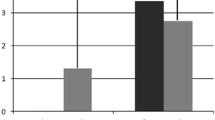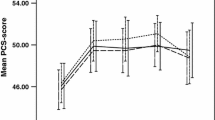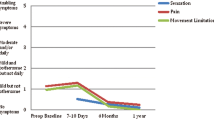Abstract
Background
Laparoscopic inguinal hernia repair has emerged as a viable alternative to the open procedure. To date, few studies have included validated measures of quality of life as end points. We compared quality-of-life outcomes following laparoscopic versus open repair of inguinal hernia.
Methods
All laparoscopic repairs were performed via the totally extraperitoneal route (TEP). All open procedures were Lichtenstein repairs (LR). Hernia repairs performed between January 1999 and December 2006 were included in the study. Data was recorded prospectively and each TEP repair was matched with a LR for analysis. The SF-36 form was used to assess quality of life. Statistical significance was determined using the two-sample Wilcoxon rank-sum (Mann-Whitney) test.
Results
Three hundred fourteen procedures were performed during the study period, 164 (52%) had a TEP repair and 150 (48%) had a LR. Ninety TEP repairs were matched with 90 LR. Recurrence rates were 3% following TEP repair and 2% following LR. There was a significant difference between the laparoscopic and open groups in terms of physical function (p = 0.0001), physical role (p < 0.0001), bodily pain (p = 0.0029), general health (p = 0.0025), and emotional role (p < 0.0001). There was no significant difference between the groups in terms of vitality (p = 0.2501), mental health (p = 0.08), or social functioning (p = 0.1677).
Conclusions
These data suggest that the TEP repair results in less postoperative pain, a quicker return to normal functional status, and improved quality-of-life outcomes with equivalent recurrence rates when compared to the LR.



Similar content being viewed by others

References
Eklund AS, Montgomery AK, Rasmussen IC et al (2009) Low recurrence rate after laparoscopic (TEP) and open (Lichtenstein) inguinal hernia repair: a randomized, multicentre trial with 5 year follow up. Ann Surg 249(1):33–38
McCormack K, Scott NW, Go PM et al (2003) Laparoscopic techniques versus open techniques for inguinal hernia repair. Cochrane Database Syst Rev 1:CD001785
Takata MC, Duh QY (2008) Laparoscopic inguinal hernia repair. Surg Clin North Am 88(1):157–178 x
Kato Y, Yamataka A, Miyano G et al (2005) Tissue adhesives for repairing inguinal hernia: a preliminary study. J Laparoendosc Adv Surg Tech A 15(4):424–428
Hallen M, Bergenfelz A, Westerdahl J (2008) Laparoscopic extraperitoneal inguinal hernia repair versus open mesh repair: long-term follow-up of a randomized controlled trial. Surgery 143(3):313–317
Tantia O, Jain M, Khanna S et al (2009) Laparoscopic repair of recurrent groin hernia: results of a prospective study. Surg Endosc 23(4):734–738
The MRC Laparoscopic Groin Hernia Trial Group (1999) Laparoscopic versus open repair of groin hernia: a randomised comparison. Lancet 354(9174):185-190
Wall ML, Cherian T, Lotz JC (2008) Laparoscopic hernia repair—the best option? Acta Chir Belg 108(2):186–191
Lamb AD, Robson AJ, Nixon SJ (2006) Recurrence after totally extraperitoneal laparoscopic repair: implications for operative technique and surgical training. Surgeon 4(5):299–307
Wright D, O’Dwyer PJ (1998) The learning curve for laparoscopic hernia repair. Semin Laparosc Surg 5(4):227–232
Toy FK, Moskowitz M, Smoot RT Jr et al (1996) Results of a prospective multicenter trial evaluating the ePTFE peritoneal onlay laparoscopic inguinal hernioplasty. J Laparoendosc Surg 6(6):375–386
Vidovic D, Kirac I, Glavan E et al (2007) Laparoscopic totally extraperitoneal hernia repair versus open Lichtenstein hernia repair: results and complications. J Laparoendosc Adv Surg Tech A 17(5):585–590
Butler RE, Burke R, Schneider JJ et al (2007) The economic impact of laparoscopic inguinal hernia repair: results of a double-blinded, prospective, randomized trial. Surg Endosc 21(3):387–390
Neumayer L, Jonasson O, Fitzgibbons R et al (2003) Tension-free inguinal hernia repair: the design of a trial to compare open and laparoscopic surgical techniques. J Am Coll Surg 196(5):743–752
Eklund A, Rudberg C, Smedberg S et al (2006) Short-term results of a randomized clinical trial comparing Lichtenstein open repair with totally extraperitoneal laparoscopic inguinal hernia repair. Br J Surg 93(9):1060–1068
Schmedt CG, Sauerland S, Bittner R (2005) Comparison of endoscopic procedures vs. Lichtenstein and other open mesh techniques for inguinal hernia repair: a meta-analysis of randomised controlled trials. Surg Endosc 19(2):188-199
Taylor C, Layani L, Liew V et al (2008) Laparoscopic inguinal hernia repair without mesh fixation: early results of a large randomised clinical trial. Surg Endosc 22(3):757–762
Gholghesaei M, Langeveld HR, Veldkamp R et al (2005) Costs and quality of life after endoscopic repair of inguinal hernia vs. open tension free repair: a review. Surg Endosc 19(6):816–821
McCormack K, Wake B, Perez J et al (2005) Laparoscopic surgery for inguinal hernia repair: systematic review of effectiveness and economic evaluation. Health Technol Assess 9(14):1–203
de Jonge P, Lloyd A, Horsfall L et al (2008) The measurement of chronic pain and health-related quality of life following inguinal hernia repair: a review of the literature. Hernia 12:561–569
Srsen D, Druzijanic N, Pogorolic Z et al (2008) Quality of life analysis after open and laparoscopic inguinal hernia repair - retrospective study. Hepatogastroenterology 88:2112–2115
Author information
Authors and Affiliations
Corresponding author
Rights and permissions
About this article
Cite this article
Myers, E., Browne, K.M., Kavanagh, D.O. et al. Laparoscopic (TEP) Versus Lichtenstein Inguinal Hernia Repair: A Comparison of Quality-of-Life Outcomes. World J Surg 34, 3059–3064 (2010). https://doi.org/10.1007/s00268-010-0730-y
Published:
Issue Date:
DOI: https://doi.org/10.1007/s00268-010-0730-y



